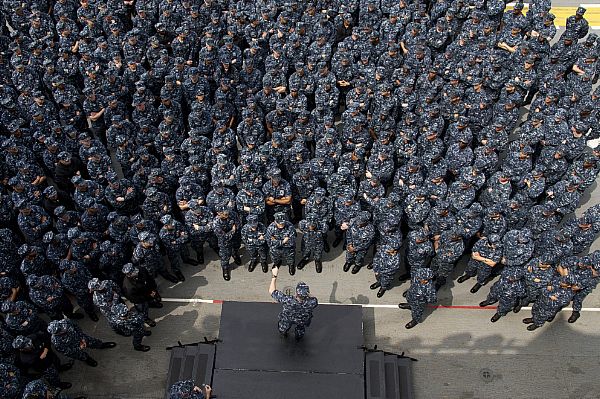(U.S. Navy photo by Senior Chief Mass Communication Specialist Joe Kane/Released)
The U.S. Navy has come under fire this week after it was revealed that its uniforms are extremely flammable and, in some cases, can actually lead to more severe burn injuries.
An impromptu test conducted October 15 by the Navy Clothing Textile Research Facility in Natick, MA found that the Navy Working Uniform Type I, a material comprised of a 50% nylon 50% cotton, will “burn robustly until completely consumed” when subjected to a flame and “melt and drip” as it burns. The test results add that the “sticky molten material” will even contribute to increased burn injury.
During the test, a small strip of the NWU Type I material was subjected to a flame for 12 seconds and the after-flame time, after-glow time, and char length were measured and any melting/dripping was recorded.
The flame resistant qualities, or lack there of, is nothing new. In fact, the Navy has known about the defect, if you can call it that, since it was discovered in October 2011. Actually, flame resistant uniforms have not been required by the Navy since 1996.
Still, the report has become quite the topic in some of the Navy’s social media outlets, and the Navy has been quick on the the damage control.
“Upfront, we need to acknowledge that since 1996 there has not been a Fleet requirement to have flame resistant working uniforms for all hands,” Rear Adm. John Kirby, Navy’s Chief of Information, said in a statement. “Where there is a need, fire retardant/flame resistant clothing is provided—damage control personnel, fire fighters, Sailors involved in flight duties, etc….”
In an additional effort to alleviate concerns, All Hands Magazine sat down with Vice Adm. Scott Van Buskirk, Commander Navy Personnel Command and President of the Navy Uniform Board and put some tough questions to him. Here’s what he had to say:
AH: The NWUs Type I were introduced in 2008/9. Why are we just now learning that they are not flame resistant?
CNP: Well, we’ve known that these uniforms were not flame resistant for some time. This is not a new notion. In fact, we detailed this in an Oct 2011 Navy Safety Center message, where it was spelled out that the Type I lacked flame resistant qualities.
There are no Navy uniforms developed purposely to fight a shipboard fire. That said, if you walk aboard any Navy ship, you will find each one is equipped with the needed fire fighting ensemble and personal protective equipment to combat fires.
So, beyond our everyday working uniforms, the required equipment needed to “fight the ship” and keep our Sailors safe is out there and readily available should the circumstances dictate its use.
AH: Given the results of the recent test — what we now know – are you comfortable with Sailors wearing NWUs at sea?
CNP: Absolutely I am. As long as it is worn in the manner and in the environment for which it was designed – just like any other uniform we have – we still believe it’s suitable for wear.
Since the mid-90’s there has been no requirement for us to have a flame resistant working uniform for all hands. There’s been no change to that requirement.
That said, in light of this impromptu test, Adm. Gortney at Fleet Forces Command is having a working group go review the requirements. If they should recommend changes, then we’ll take a look at that. But again, the uniform is still approved for wear aboard a ship. What we need to focus on is wearing it properly and in the right environments – sea and ashore environments that do not require special clothing (e.g., flight, flight deck, engine room, etc.).
AH: Some media reports have argued that the NWU is less safe than the uniforms that it replaced—your thoughts?
CNP: I don’t agree with those assertions. This uniform offers the same level of protection as the uniforms they replaced. Again, let me be clear, I am very comfortable with Sailors wearing this uniform—provided they wear it correctly and in the manner in which it was designed.
AH: Are you comfortable with Sailors fighting fires in this uniform?
CNP: Yes, in the appropriate cases, I am. Look, we know NWUs–which are not made of, or treated with, flame resistant material are not meant to be a firefighting uniform–nor were those uniforms they replaced.
I believe Sailors understand this uniform can be worn to take appropriate first responder action to combat a fire. Beyond that, they need to don more advanced protective gear. Would I expect a Sailor to leave a space where there is a small fire, one that could be controlled or extinguished before it progressed, simply because that Sailor wasn’t in their fire fighting ensemble? The answer is No.
I would expect that the Sailor would do their best to put that fire out– if the situation became such that the fire advanced and added PPE was needed–that Sailor should leave the space in time or call for help. Our folks know this.
Continue Reading…
So what do you think: Should the Navy change its uniforms or is there no use crying over spilled milk?

 Join The Club
Join The Club











